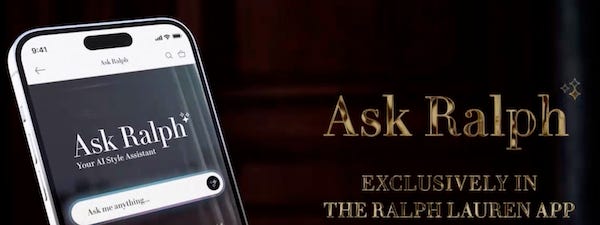The “Hideous Phantasm” of AI; or Why Content Strategy is Key for Getting Value from AI Investment
FSW explores the current state of AI in luxury and why content strategy remains critical for real results.
Insights
While AI offers transformative possibilities for content creation and customer experiences in the luxury sector, its adoption must be strategic. Without a clear purpose, AI risks producing generic, low-impact content that fails to resonate with luxury consumers.
Holistic content strategy is essential for luxury brands to effectively integrate AI. This includes defining brand voice, goals, and audience needs to ensure AI-generated content aligns with the brand's vision and values, avoiding the pitfalls of "junk content."
AI is reshaping how consumers discover and shop for luxury products online, with tools like agentic AI bots enhancing customer experiences. However, the success of such innovations depends on meaningful contextualization and structured content to support AI's capabilities.
Luxury brands should prioritize authentic storytelling and human creativity over the "wow factor" of AI. High-quality, emotionally resonant content remains a key differentiator in building brand loyalty and exclusivity.
Rather than replacing human creators, AI should be used to empower content teams by automating repetitive tasks, generating ideas, and enhancing efficiency. Human expertise and creativity remain irreplaceable in crafting compelling, original luxury brand narratives.
In the introduction to her novel Frankenstein, Mary Shelley writes of her vision for the story:
“I saw the hideous phantasm of a man stretched out, and then, on the working of some powerful engine, show signs of life, and stir with an uneasy, half vital motion. Frightful must it be; for supremely frightful would be the effect of any human endeavor to mock the stupendous mechanism of the Creator of the world.”
This celebrated “ghost story” (as she calls it) imagines a ghastly future and questions the moral, ethical, and philosophical repercussions of humans trying to recreate “the effect of human endeavor” and play the role of god. (Watch this space for a review of Guillermo del Toro’s adaptation of Mary Shelley’s story later this fall.)
In the retail, fashion, and luxury space, we are currently amidst a not-so-quiet revolution in practical applications of artificial intelligence (AI) for business and commerce, thanks to the introduction of tools like generative AI (ChatGPT-5, Claude, Jasper, and the like), agentic AI, and related natural language/AI search engines from OpenAI, Google, Perplexity, and others.
In some camps, AI myth-making is in full force with tech enthusiasts now all over generative AI with gusto, pronouncing a new future of automated, machine-run content at scale wherein brands, marketers, and content creators can generate high-quality content at the push of a button.
Putting all the popular hype aside, AI, perhaps, more specifically, generative AI, offers real possibilities to transform—or disrupt, transmogrify, recreate, reimagine, and reconstitute—the business of content and commerce. It also may have real consequences for how we as humans use language for communication and how we articulate our ideas in writing, such as AI’s rampant usage of punctuation like emdashes and more formal vocabulary.
But, what does AI mean for luxury brands and how we shop online, never mind the future of content and brand storytelling? How do brands understand what is important about AI for luxury content and what is not in order to “avoid another disappointment like the metaverse,” as one client recently told us? How do we manage the risks of AI while taking advantage of the positives?
BCG says luxury experience “needs an AI moment” in order “to meet rapidly changing customer expectations, scale white-glove service, and shorten their learning curve,” but are they right? What does this actually mean in practice?
When it comes to luxury content, storytelling, and customer experience, we firmly believe that brands should approach technologies like AI with a mix of humility, humanity, curiosity, and awareness. As always with content, structure, meaning, intent, and context matter. Technology comes and goes. Luxury brand storytelling should be forever.
Agentic AI and Luxury Customer Experience
Ralph Lauren is the latest luxury brand to come out with a branded AI agent and tout its take on AI innovation. The “Ask Ralph” styling bot is all about frontline customer experience, allowing customers to ask questions and get styling and product recommendations. According to the Business of Fashion, the brand believes that what “makes its AI chatbot different from others to hit the market is that it leverages Ralph Lauren’s deep archive of content to offer inspiration and guidance on how to put pieces together into Ralph Lauren-approved outfits.”
This Ralph Lauren announcement comes on the heels of the MIT report that concludes 95% of generative AI pilots are failing, largely due to a lack of return on investment (ROI) and strategic corporate alignment. The “Ask Ralph” bot will be one to watch; but the critical question concerns the “why” for this type of innovation project in today’s luxury market. Despite all the marketing hype from major brands about their AI rollout or from the media that “AI shopping ‘agents’ set to transform ecommerce,” agentic AI for luxury clienteling is nothing new. Zegna has been using Zegna X behind the scenes for clienteling since 2023.
At times, the impulse towards AI-everything feels like the Metaverse 2.0. In retail contexts, consumers should be prepared for a lot of potentially generic, buggy tech that may or may not be useful for anything they are trying to do. All the media coverage of this Ralph Lauren agentic AI launch is the latest chapter in a long line of media announcements that this or that innovation in AI will capture consumer imagination and build brand loyalty.
As always with tech and customer experience design, our questions are: who are all of these AI innovations for? Do luxury consumers really care about having a branded bot? Do they actually care about having AI anything? Or do they just want fair prices, exclusive products, and better customer service?
As we have extensively explored in terms of the need for content-first approaches to retail tech, innovation within luxury needs to be appropriately and meaningfully contextualized within a brand, using technology to empower more human-focused customer experiences that actually drive value both for brands and customers.
To go back to the questions of who all these AI projects are for and whatdo brands actually need to make them scale and add value, the answer to those of us who have been working in content strategy for over two decades is hardly a mystery. Content strategy can bring meaning, value, and context to AI applications (and innovation in general) within brands, allowing technology to play a useful role in shaping consumer experience. Content strategy can improve the effectiveness of e-commerce, streamline data collection, more efficiently target the right consumers and improve user research and analysis, and, ultimately, garner better outcomes in terms of sales, product-based customer decisions, and overall brand growth.
AI Search, Structured Content, and the Semantic Future of Shopping

With headlines that companies like Lyst are refocusing their business models to focus on the AI-powered search for luxury shopping or that more luxury customers than ever are turning to TikTok and Instagram over Google for initial product discovery, it is clear that the luxury consumer e-commerce paradigm is shifting. Exactly which way it is shifting—whether into AI-driven models, offline experiences, social shopping, or some combination of the three—is up for significant debate. Nevertheless, it seems inescapable that AI is already playing a major role in changing how we find, discover, search, and shop for luxury products online and, in turn, what we think of the brands that sell them.
The problem with the rapid adoption of AI in luxury e-commerce contexts is that most luxury content is unstructured and not backed by foundational semantic ontologies or knowledge graphs to define and integrate domain knowledge, codify and connect data, and explain retrieval logic to drive more useful, contextualized AI outputs. AI thrives on the meaningful associations and architecture of structured content to “reason” and help make sense of a morass of information and data. In spite of the acceleration in AI “innovations” across the luxury sector, there unfortunately is minimal investment in holistic content strategy and structured content as foundational operational infrastructure, even among brands that have taken the time to formalize how they approach product inventory management and digital asset management.
(For background on how AI and natural language search works, we highly recommend Deborah Carver’s excellent work for The Content Technologist, such as her piece, “How does AI make sense of language?”)
To add to the chaos, many tech providers and content marketers are trying to convince brands that they need “Generative Engine Optimization (GEO)” to build “AI readiness” or “AI search optimization” as a way to shift their SEO/SEM budgets. Anyone who has spend five minutes studying how AI search works will tell you that this is a marketing ploy designed to obfuscate rather than educate.
The simple fact is that the best way to ready your brand content (which includes your PDP or production description pages, social media posts, and more editorial brand storytelling) for the new world of AI search is to invest in quality, authentic content that describes what you do, how you are different, what you sell, and why you do what you do.
In short, luxury brands need holistic content strategy and content operations to drive meaningful, contextualized applications of AI that actually make sense for their corporate vision, their products, and their target consumers.
When it comes to tech and AI, content strategy is also essential corporate risk mitigation. How do luxury brands protect their data, their customers’ data, and their systems and tools, and weather external factors like cyberattacks, phishing, and copyright infringement? A strong content strategy is a form of risk management, embedding governance, policies, metadata standards, and workflows that by their nature protect sensitive brand and customer data. Through prioritizing privacy, consistency, and ethical oversight, content strategy reduces the risk of data breaches, reputational damage, and misaligned personalization. It also functions to future-proof luxury brands against evolving global regulations, ensuring secure scalability and sustained consumer trust.
AI and the Shape of Luxury Storytelling
From a marketing and communications angle, the future of AI and luxury content is still being written. We cannot with any confidence predict a future of fully autonomous brand marketing and social content (or “liquid content” as Matthieu Lorrain at Google DeepMind calls it) any more than we can say it is just a passing trend (or one that will truly devastate the modeling industry). This is not to say that the uncanny ability of ChatGPT to write strong product descriptions, Instagram posts, and marketing campaigns should be ignored; but rather that this capability needs to be thought through, interpreted, and incorporated into a wider brand content strategy in order to be properly operationalized.
In short, for luxury brands, where will the most value-add for AI-driven content arise? It’s hard to say at this point. But, there are some best practices emerging for AI applications for content and content strategy.
Before you use AI, invest in content strategy.
If your brand is already struggling to produce and manage content across channels and does not have in place a foundational content strategy to drive content decision making and planning over time, then AI could actually make things worse. Why? You could easily lose customers if the AI is not properly trained in your brand voice and produces content that is not well targeted to your vision, your product, and, well, your words.
Automating content without purpose or vision basically turns whatever output the AI generates into junk content that won’t resonate or have any impact on your target audiences.
Know what content problem you need the AI to solve.
Following on from the idea of junk content, using AI for AI’s sake is not a great choice when it comes to content for brands of any size. This is why we continually recommend approaching AI tools with a strong strategy with a set of clear vision-based goals and success measures in hand.
Is it a good thing for ChatGPT to write all your Instagram posts? If you’ve been having interns handle Instagram for years and it isn’t a priority channel, that’s one thing.
But, if you’re a luxury brand all about exclusivity, provenance, and quality, then considering an investment in AI for content is an entirely different matter. For fashion and luxury brands, authentic, quality content that empowers and enriches your brand story across channels is arguably your biggest asset. So, relying on an AI author to create your social media posts as a luxury brand may not be the best move.
That said, if you’re a luxury retailer struggling to keep up with the pace of writing product descriptions every time you introduce a new product, generative AI is a perfect tool to help your content teams automate and templatize laborious content creation processes. Or, if you’re a luxury marketer trying to understand the history of a specific trend, AI can give you a quick comprehensive deep dive into any particular topic.
Focus on storytelling, not the tech wow factor.
Tell better stories across platforms. Use beautiful words to bring beautiful clothes to life. If you want to differentiate your brand from your competitors, focus on:
Identifying your target audiences and how they are similar and different
Understanding what these audiences need, the types of content they prefer, and the patterns in how they consumer it—in other words, your customer journeys
Delineating your brand content vision and goals
Identifying all your brand content touchpoints, both for digital channels and IRL ones from your website to retail stores and influencer marketing partnerships
In our opinion, the future of fashion criticism and trends analysis is now more critical than ever to provide educated, historically-situated, experience-driven insights about the fashion and luxury industry. These are expert functions that no AI can fulfill.
Given where we are with AI technologies, by all means, use AI to ideate if you get stuck or to generate new ideas if you are feeling spontaneous. Or even, use AI for UX to generate personas, conduct ideal-state user research, and write user stories. But, don’t rely on AI to write and deliver all your brand messaging if you want to build meaningful relationships with consumers and to give them reasons to keep engaging and coming back.
Empower your content teams.
Do not take the easy way out and think that AI is more powerful to reach consumers than the writers, editors, social media strategists, and marketers team you currently have on staff.
The current state of AI runs out of steam in creating what we can only call vaguely “high-quality, original content based on the vicissitudes and unpredictabilities of actual human experience.” AI cannot live a life for you. Even if you ask AI to write a sea shanty, it still lacks the spontaneity and imaginativeness of human-written poetry. AI takes a formulaic, slightly personality-less approach to content creation and is only as good as the information and data that went into its inputs, which is not necessarily the best formula for luxury brands looking to make clothing feel desirable and exclusive to drive consumers to purchase.
Want a new future for luxury content? Build a content strategy and give your existing teams more opportunities to collaborate and develop innovative stories, build connections, and create meaningful experiences for your consumers. AI is a fascinating tool to help creators imagine new possibilities and build new worlds; but, it needs supervision and nuancing in order to situate it most powerfully within an organization.





